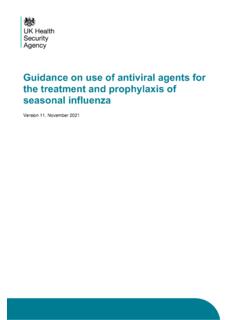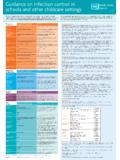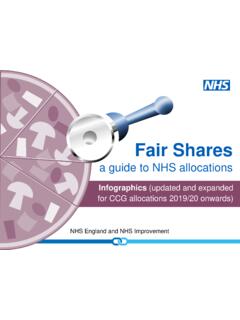Transcription of The national influenza immunisation programme 2021 to …
1 The national influenza immunisation programme 2021 to 2022. Published August 2021. Version 1. The national influenza immunisation programme 2021 to 2022: Inactivated influenza vaccine information for healthcare practitioners Contents Document history .. 3. influenza vaccination programme 2021 to 2022 and control measures to prevent the spread of coronavirus (COVID-19).. 4. Background and 2021 to 2022 programme summary .. 5. Key documentation .. 6. influenza .. 7. influenza vaccination programme .. 8. Legal frameworks to supply and/or administer flu vaccines .. 8.
2 Vaccine eligibility .. 9. Pregnancy and breastfeeding .. 10. influenza vaccine and its components .. 12. Recommendations for the use of inactivated influenza vaccine .. 16. Inactivated vaccines available during 2021 to 2022 .. 19. Recommendations for the use of Live attenuated influenza vaccine (LAIV) .. 22. Live attenuated influenza vaccine (LAIV) .. 23. Transmission of vaccine virus in LAIV .. 24. Number of influenza vaccine doses required (inactivated and LAIV vaccines) .. 26. Contraindications and precautions .. 28. Vaccine ordering and national supply of additional adult vaccine.
3 31. Vaccine storage .. 32. influenza vaccine preparation .. 33. Vaccine administration .. 34. Adverse reactions .. 36. Common issues .. 38. Reference list .. 50. Useful 52. 2. The national influenza immunisation programme 2021 to 2022: Inactivated influenza vaccine information for healthcare practitioners Document history Version number Change details Date New information document August 2021. 3. The national influenza immunisation programme 2021 to 2022: Inactivated influenza vaccine information for healthcare practitioners influenza vaccination programme 2021 to 2022 and control measures to prevent the spread of coronavirus (COVID-19).
4 This document contains information on the influenza vaccination programme 2021 to 2022, the inactivated influenza vaccine and the Live Attenuated influenza Vaccine (LAIV). It may be updated throughout the year with any new information that becomes available as the flu vaccination season progresses. The final section of this document provides additional information and advice on common issues that may be encountered whilst delivering the flu immunisation programme . JCVI have published interim advice on COVID-19 booster vaccination. As booster doses of COVID-19 vaccine are currently being considered trials are taking place to ascertain whether co-administration of COVID-19 vaccine and influenza vaccine will be permissible, subject to the advice of JCVI.
5 It is recommended that you read the letters and resources available on the PHE Annual flu programme webpage and that you also read the information and resources available on the PHE COVID-19 vaccination programme webpage during the flu vaccination period. These webpages should be regularly checked as any further information that becomes available about the flu vaccination programme or the COVID-19 vaccination programme will be published there. Further programme updates may also be reported in Vaccine Update so please subscribe using the link for New subscribers if you are not currently a subscriber.
6 As COVID-19 is likely to continue to co-circulate with flu this winter, those involved in delivering this year's flu vaccine programme should ensure that they are aware of the specific guidance that they should follow in order to safely and effectively deliver flu vaccines, including recommendations around the use of personal protective equipment (PPE) in keeping with the current advice from the Government. 4. The national influenza immunisation programme 2021 to 2022: Inactivated influenza vaccine information for healthcare practitioners Background and 2021 to 2022 programme summary In the situation where social mixing and social contact return towards pre-pandemic norms, it is expected that winter 2021 to 2022 will be the first winter in the UK when seasonal influenza virus (and other respiratory viruses) will co-circulate alongside COVID-19.
7 Seasonal influenza and COVID-19 viruses have the potential to add substantially to the winter pressures usually faced by the NHS, particularly if infection waves from both viruses coincide. The timing and magnitude of potential influenza and COVID-19 infection waves for winter 2021 to 2022 are currently unknown, but the JCVI. interim advice stated that mathematical modelling indicates the 2021 to 2022 influenza season in the UK could be up to 50% larger than typically seen and it is also possible that the 2021 to 2022 influenza season will begin earlier than usual.
8 The seasonal influenza vaccination programme was introduced in England during the late 1960s to protect those in clinical risk groups. These groups were found to be at higher risk of influenza associated morbidity and mortality. Since then, the programme has been extended to include all those aged 65 years and over (in the year 2000), pregnant women (in 2010), those with a body mass index (BMI) of 40 or more (2016). and children (2013). During 2020 to 2021 an expanded offer was made which enabled those aged 50 to 64. years to receive the flu vaccine as part of an NHS funded programme .
9 This offer will continue for this age group, as a temporary measure, for the 2021 to 2022 programme . Studies commissioned by JCVI (1) suggested that, despite the high cost, extending the flu vaccination programme to all children is highly likely to be cost-effective and well below the established cost-effectiveness threshold when indirect protection to the whole population is considered, particularly over the longer term. This is because offering influenza vaccine to healthy children not only provides individual protection to the child, it also reduces transmission across all age groups to lessen levels of flu activity overall and reduces the burden of flu across the population.
10 Pebody and others (2) reported reductions in GP consultations for influenza -like illness, swab positivity in primary care, laboratory confirmed hospitalisations and percentage of respiratory emergency department attendances. The programme for children was recommended in 2012 by JCVI (3) and has been phased in over a number of years beginning in 2013 with additional age groups being added each year. This year, the childhood flu vaccination programme has been extended to include, as a temporary measure, all children from Year 7 to Year 11 in secondary schools (all children between 2 and 15 years old (but not 16 years or older).)














